Related Research Articles

Sarajevo is the capital and largest city of Bosnia and Herzegovina, with a population of 275,524 in its administrative limits. The Sarajevo metropolitan area including Sarajevo Canton, East Sarajevo and nearby municipalities is home to 555,210 inhabitants. Located within the greater Sarajevo valley of Bosnia, it is surrounded by the Dinaric Alps and situated along the Miljacka River in the heart of the Balkans, a region of Southern Europe.

The siege of Sarajevo was a prolonged blockade of Sarajevo, the capital of Bosnia and Herzegovina, during the Bosnian War. After it was initially besieged by the forces of the Yugoslav People's Army, the city was then besieged by the Army of Republika Srpska. Lasting from 5 April 1992 to 29 February 1996, it was three times longer than the Battle of Stalingrad, more than a year longer than the siege of Leningrad, and was the longest siege of a capital city in the history of modern warfare.
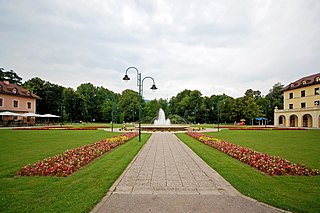
Ilidža is a town and a municipality located in Sarajevo Canton of the Federation of Bosnia and Herzegovina, an entity of Bosnia and Herzegovina. It has a total population of 66,730 with 63,528 in Ilidža itself, and is a chief suburb of Sarajevo and de facto its neighborhood. It is best known for the Vrelo Bosne spring, as well as the natural environment of its surroundings and historical tradition dating back to Neolithic times. Sarajevo International Airport is located nearby.

Oslobođenje is a daily newspaper in Bosnia and Herzegovina based in the capital city Sarajevo. Founded on 30 August 1943, in the midst of World War II, on a patch of territory liberated by Partisans, in what was otherwise a German-occupied country, the paper gained recognition over the years for its high journalistic standards and is recipient of numerous domestic honors and international awards in a branch.

Sarajevo Tobacco Factory was a cigarette producer with headquarters in Sarajevo, Bosnia and Herzegovina.
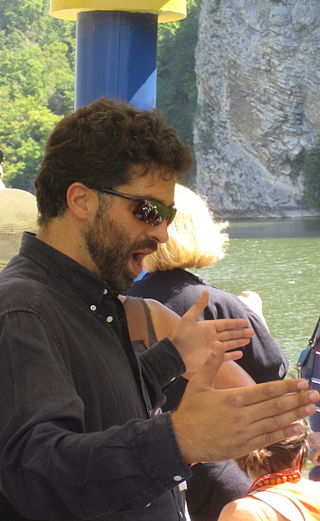
Danis Tanović is a Bosnian film director and screenwriter. He is best known for having directed and written the script for the 2001 Bosnian movie No Man's Land which won him many awards, including an Academy Award for Best Foreign Language Film and a Golden Globe Award for Best Foreign Language Film among many others.

The University of Sarajevo is a public university located in Sarajevo, Bosnia and Herzegovina. It is the largest and oldest university in the country, tracing its initial origins to 1537 as an Islamic madrasa.

The history of Jews in Bosnia and Herzegovina spans from the arrival of the first Bosnian Jews as a result of the Spanish Inquisition to the survival of the Bosnian Jews through the Holocaust and the Yugoslav Wars. Judaism and the Jewish community in Bosnia and Herzegovina has one of the oldest and most diverse histories in the former Yugoslav states, and is more than 500 years old, in terms of permanent settlement. Then a self-governing province of the Ottoman Empire, Bosnia was one of the few territories in Europe that welcomed Jews after their expulsion from Spain.

Haris Pašović is a Bosnian theatre director. Over the course of his career, he has also worked as a playwright, producer, choreographer, performer, and designer. He is best known for his productions of Wedekind's “Spring Awakening”. He is the artistic leader of the East West Theatre Company in Sarajevo and tenured Professor of Directing at the Academy of Performing Arts in Sarajevo.

Our Party is a social-liberal and multi-ethnic political party in Bosnia and Herzegovina, founded in 2008. Its current leader is Edin Forto. The party's founders are the Bosnian directors Danis Tanović and Dino Mustafić. The party aims to break the dominance of nationalist parties in the Bosnian political system. On 4 June 2016, Our Party became a member of the Alliance of Liberals and Democrats for Europe.
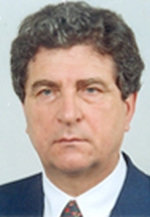
Hasan Muratović was a Bosnian politician, entrepreneur and professor. He served as the 4th and last Prime Minister of the Republic of Bosnia and Herzegovina from 30 January 1996 to 3 January 1997. Muratović was also known for his long-term professorship at the Faculty of Economics and the Faculty of Electrical Engineering at the University of Sarajevo. He was also a rector of the University of Sarajevo from 2004 until 2006.

Sarajevo City Hall, known as Vijećnica, is located in the city of Sarajevo, Bosnia and Herzegovina. It was designed in 1891 by the Czech architect Karel Pařík, but criticisms by the minister, Baron Béni Kállay, caused him to stop working on the project. It was initially the largest and most representative building of the Austro-Hungarian period in Sarajevo and served as the city hall.

Trams in Sarajevo are a part of the public transport system in Sarajevo, the capital city of Bosnia and Herzegovina. The system is run by KJKP GRAS Sarajevo, which also operates trolleybus and bus routes in the city.
East West Theatre Company was established in 2005 in Sarajevo, Bosnia and Herzegovina. It is a nonprofit cultural institution which produces performing arts programs, publications, films, and music events. It also organizes touring shows, discussions, forums, master-classes and workshops. Important components of its work include a creation of new work and a commitment to international cooperation.
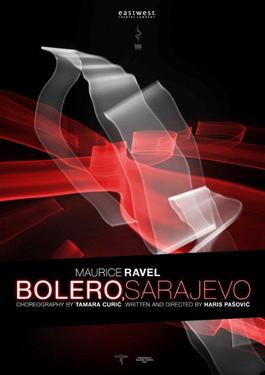
Bolero, Sarajevo or shortened Bolero is the name of a theatre show produced by the East West Theatre Company from Bosnia and Herzegovina and Tala Dance Center from Croatia. Authors, choreographer Tamara Curic from Zagreb, Croatia and director Haris Pasovic, created a dance performance in which Sarajevo and choreography impressed with Maurice Béjart's work are in interaction. They were largely inspired by the flux of Sarajevo, Ravel's music and 'Béjartesque' swinging bodies. Performance included dancers from Zagreb who regularly collaborate with the TALA Dance Centre, actors of the East West Theatre Company from Sarajevo, and the members of the Sarajevo National Theatre's Ballet Company.

Sarajevo Red Line is the name of the memorial event organized in cooperation between the City of Sarajevo and East West Theatre Company which commemorated the Siege of Sarajevo's 20th anniversary. It was held April 6, 2012, in the main Sarajevo street and it consisted of a large chair installation, street exhibition of war posters and a concert. Authors describe Sarajevo Red Line as a drama and music poem dedicated to the Sarajevo citizens killed during the 1992-96 siege of their city.
Anur Hadžiomerspahić, also known as Anur, was an artist and graphic designer from Bosnia and Herzegovina. He was notable for being the first Bosnian artist to show their work in the central pavilion at the Venice Biennale.

The Jazz Fest Sarajevo is an international music festival held annually during the first week of November in Sarajevo and is the largest of its kind in Southeastern Europe.
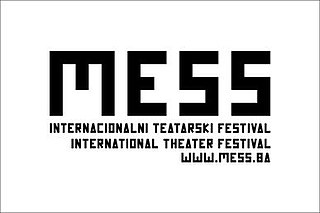
The MESS International Theatre Festival (MESS) is a theatre festival that takes place annually in Sarajevo, Bosnia and Herzegovina. It is the oldest living theatre festival in the Balkans, programming international experimental performances and emerging artists. MESS was the largest theatre festival in the Former Yugoslavia and was named one of Living Theatre's international showcases in 1974. It survived the Siege of Sarajevo, during which it hosted directors such as Susan Sontag and Peter Schumann. It organized the first edition of the Sarajevo Film Festival in 1993 and still acts as a collective board member today. Today it is the largest theatre festival in Bosnia and Herzegovina and one of the largest in South-Eastern Europe. In 2009 it expanded its activities to the city of Zenica, which now hosts parts of the regional program.

Sarajevo, the capital of Bosnia and Herzegovina has gained international notoriety for its diverse range of street art and associated subcultures. The city has a long history of street art that was first tied to various subcultures in the 1970s and 1980s. During the Bosnian war political and anti-war street art was one of the main artistic focal points of the besieged city. Today, Sarajevo is a European center for street art and hosts two international festivals dedicated to the art form.
References
- ↑ Kapic, Suada (2000). The Siege of Sarajevo. Sarajevo: FAMA. p. 546. ISBN 9958-9549-0-7.
- ↑ West, Charlotte. "A Reborn Sarajevo Serves as Muse to its Young Designers". OF+W Media. Retrieved 15 March 2012.
- ↑ "FABRIKA HOME" . Retrieved 15 March 2012.